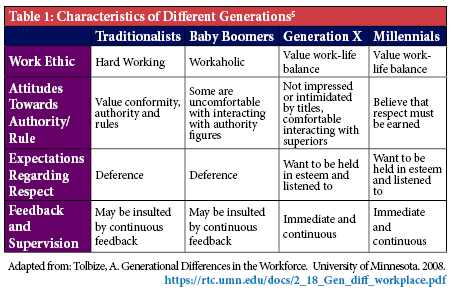Official Newsjournal of the Illinois Council of Health-System Pharmacists
Educational Affairs
Precepting For The Future
by Rachael Prusi, PharmD, MSGH
- Provide clear direction and structure – Millennials prefer when performance expectations are communicated up-front. By providing clear direction, this can avoid frustration and miscommunication for both the learner and preceptor.7 Do not assume that expectations are known by either party.
- Role model, coach and mentor – Research supports that Millennials prefer authentic and partnership leadership styles. By role modeling and coaching, we can facilitate an authentic experience and motivate learners who want to feel that their preceptor is personally committed to the profession and their professional growth.7,8
- Engage and provide feedback – As described above, Millennials expect and prefer frequent and timely feedback. Consider limiting use of the “feedback sandwich” as learners can miss what the important take-aways were from all of the content. Instead the “Situation, Behavior, Impact” model which focuses on a specific action or behavior, allows learners to precisely understand exactly what you are commenting on and why:9,10
Situation – Describe the situation, be specific
Behavior – Describe the observable behavior
Impact – Describe what you thought or felt in reaction to the behavior - Team based learning – Millennials prefer collaboration, therefore adapting opportunities for team based activities and projects is an effective method to improve retention and learning outcomes in certain situations.11
- Utilize technology – As Millennials feel very comfortable with technology, appropriate utilization can assist with engaging and communicating with this generation on their level. It is recommended to use one mutually agreeable technology platform across the experience, such as Schoology, a free Learning Management System.11,12 In addition, it is important to set expectations for other technology use during the experience such as “no mobile phones during rounds” that are clear and understood and that preceptors should model the behavior that they expect to see.

- Tipton D. Personal and Professional Growth for Health Care Professionals. Burlington, MA: Jone & Barlett Learning; 2017.
- McCrindle M. Understanding Generation Y. Australian Leadership Foundation 2005. http://www.communicationcache.com/ uploads/1/0/8/8/10887248/understanding_ generation_y.pdf. Accessed March 20, 2017.
- Alsop R. The Trophy Kids Grow Up. San Francisco, CA: Jossey-Bass; 2008.
- Fry, Richard. “Millennials Are Largest Generation in the U.S. Labor Force.” Pew Research Center, Pew Research Center, 11 Apr. 2018, www.pewresearch.org/fact-tank/2018/04/11/millennials-largest-generation-us-labor-force/.
- Tolbize, A. Generational Differences in the Workforce. University of Minneasota. https://rtc.umn.edu/docs/2_18_Gen_diff_workplace.pdf. 2008.
- Goleman, Daniel. “Leadership That Gets Results.” Harvard Business Review, 11 Apr. 2019, hbr.org/2000/03/leadership-that-gets-results.
- Williams, Valerie N., et al. “Bridging the Millennial Generation Expectation Gap: Perspectives and Strategies for Physician and Interprofessional Faculty.” The American Journal of the Medical Sciences, vol. 353, no. 2, 2017, pp. 109–115.
- Brack, J. Maximizing Millennials in the Workplace. University of North Carolina Kenan Flagler Business School. 2012.
- “Use the SBI Feedback Model to Understand Intent: CCL.” Center for Creative Leadership, www.ccl.org/articles/leading-effectively-articles/closing-the-gap-between-intent-and-impact/.
- “The Situation – Behavior – Impact Feedback Tool: Providing Clear, Specific Feedback.” The Situation-Behavior-Impact-Feedback Tool - From MindTools.com, www.mindtools.com/pages/article/situation-behavior-impact-feedback.htm.
- Toohey, Shannon, et al. “Ten Tips for Engaging the Millennial Learner and Moving an Emergency Medicine Residency Curriculum into the 21st Century.” Western Journal of Emergency Medicine, vol. 17, no. 3, 2016, pp. 337–343.
- Schoology. “LMS: Schoology.” Learning Management System, www.schoology.com/.
Contents
Columns
Small & Rural Hospitals Network
ICHP Leadership Spotlight Interviews
ICHP Leadership Spotlight Interviews
Features
2020 Member Greeting/7 Ways to get MORE out of your ICHP membership in 2020
College Connection
Midwestern University Chicago College of Pharmacy
Roosevelt University College of Pharmacy
Rosalind Franklin University College of Pharmacy
Southern Illinois University Edwardsville School of Pharmacy
University of Illinois at Chicago College of Pharmacy
More
Regularly Scheduled Network Meetings
Chicago Area Pharmacy Directors Network Dinner
3rd Thursday of Odd Months
5:30pm
Regularly Scheduled Division and Committee Calls
Executive Committee
Second Tuesday of each month at 7:00 p.m.
Educational Affairs
Third Tuesday of each month at 11:00 a.m.
Government Affairs
Third Monday of each month at 5:00 p.m.
Marketing Affairs
Third Tuesday of each month at 8:00 a.m.
Organizational Affairs
Fourth Thursday of each month at 12:00 p.m.
Professional Affairs
Fourth Thursday of each month at 2:00 p.m.
New Practitioner Network
Second Thursday of each month at 5:30 p.m.
Technology Committee
Second Friday of each month at 8:00 a.m.
Chicago Area Pharmacy Directors Network Dinner
Bi-monthly in odd numbered months with dates to be determined. Invitation only.
